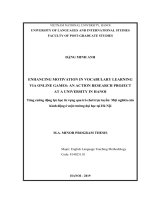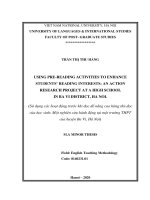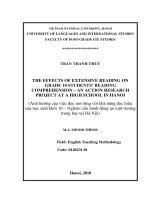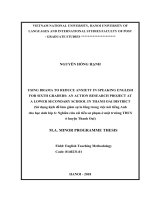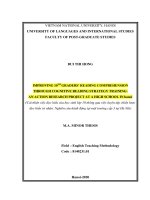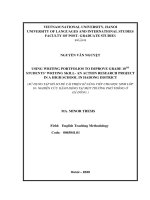MR1 group 4 group research project part a proposal
Bạn đang xem bản rút gọn của tài liệu. Xem và tải ngay bản đầy đủ của tài liệu tại đây (949.83 KB, 9 trang )
1
2
CONTENTS
I. INTRODUCTION ..................................................................................................................... 4
II. PROBLEM STATEMENT ..................................................................................................... 4
III. RESEARCH OBJECTIVES ................................................................................................. 4
IV. LITERATURE REVIEW ...................................................................................................... 4
V. RESEARCH DESIGN ............................................................................................................. 5
VI. SAMPLING PLAN ................................................................................................................. 6
VII. QUESTIONNAIRE .............................................................................................................. 6
VIII. ETHICAL ISSUES .............................................................................................................. 8
REFERENCES .............................................................................................................................. 9
3
I. INTRODUCTION
Sumo Salad is an Australian healthy food restaurant chain established in 2003 with the
purpose of making Australia a healthier and happier place by serving the customer nutritious,
convenient, and tasty meals (Baylis, as cited in O’Brien, 2017). This proposal aims to identify
the Sumo Salad position in the restaurant chain market and current consumer behaviors as well
as lifestyle.
II. PROBLEM STATEMENT
The positioning of the brand in consumers’ eyes might be different from which the company is
constructing and pursuing. Therefore, annual research is conducted to measure brand health and
positioning.
III. RESEARCH OBJECTIVES
To determine the brand awareness and brand positioning to the consumers.
To measure customers’ satisfaction about Sumo Salad products.
To survey customers’ wishes relating to nutrition facts of Sumo Salad products.
IV. LITERATURE REVIEW
Sumo Salad has found many opportunities in the fast food market with its low cost and
healthy meal. Bucolo et al. (2013) states that Sumo Salad has best provided a salad-based meal
thanks to its market acumen and its ability to meet consumer demand for healthy food at low
prices. Satisfying consumer demand, good product quality along with reasonable prices are the
contributing factors to help Sumo Salad position its brand. Price, product quality, and service are
some of the factors that create customer satisfaction and affect brand image (Khadka &
Maharjan, 2017).
Deloitte’s ImagineSydney series (2017) said that Sumo Salad is the largest healthy fast
food brand in Australia and making Australia healthier is its mission. Sumo Salad always creates
real experiences along with the tradition of fast food and provides freshness to consumers. Sumo
Salad constantly researches the market, consumer behavior and domestic and global culinary
trends to ensure the development and position of the brand in the hearts of consumers.
4
Carrad & Miller (as cited in Fellows, 2018) has stated that consumers have a growing
need for nutritious and convenient foods based on their busy lifestyles and healthy eating. Since
entering the market, Sumo Salad has attracted many potential customers and is a direct
competitor of other brands (Fellows, 2018). Sumo Salad has captured the technology trend in its
brand by applying a mobile application to customize the customer’s meal.
The method for Sumo Salad to become a famous brand is the excitement it brings along
with the establishment of an active brand that promotes healthy lifestyles (Kelly, 2014). It can be
seen that Sumo Salad always prioritizes the needs of customers, typically the preference of
ready-made salads. In addition, Sumo Salad emphasizes that its brand is always proactive in
securing a local location. (Kelly, 2014).
Most cultures in Australia do not promote nutritional products and hence Sumo Salad
was created to deliver a powerful and nutritious meal (Toutounji, 2019). Sumo Salad has
established itself as Australia’s first fresh and healthy food brand. Aiming to change the way
consumers eat and consume nutrition, Sumo Salad has been constantly changing; it not only
focuses on a small market but towards a wider audience and stronger purpose. Understanding
customers is what Sumo Salad always focuses on to find out what they want and make
appropriate business decisions.
V. RESEARCH DESIGN
To tackle the established research objectives and assist Sumo Salad in determining its
brand positioning, the research design will collect and analyze appropriate data through means of
exploratory and descriptive research. The project will first use exploratory research, which is
defined as an unstructured and informal research type (Burns et al., 2017, pp. 91-113), to gain
understanding of the current situation and generate hypotheses that are relevant to the topic. In
particular, a literature search is conducted to obtain secondary data via internet sites and journal
articles. The data collected from these sources provides comprehension of the current climate for
healthy food brands in Australia, and Sumo Salad’s business operations as well as competitive
differentiation. Subsequently, a descriptive research takes place, which, as Burns et al. (2017, pp.
91-113) also explained, is a research type often used to describe a target demographic based on
their answers for more specific “who, what, when, how” questions. On that account, the project
5
utilizes cross-sectional studies and implements a questionnaire to collect primary data. The main
aim of this research method is to understand the target market’s perception of and factors
affecting their attitudes towards the Sumo Salad brand, its offerings and the overall healthy food
segment. Detailed information of respondents, for example, their ages, genders, and education
levels, will also be acquired. The findings accumulated from the exploratory and descriptive
research will thus be used in formulating analytical rationales to address the research objectives,
at the same time providing justifications to evaluate Sumo Salad’s position in the market.
VI. SAMPLING PLAN
The proposal uses a probability sampling method which means respondents are selected
randomly. The target population is anyone in Australia who has heard about Sumo Salad.
Therefore, the questionnaire is sent to participants via Gmail or social media platforms aimlessly
based on data collected from old customers. In addition, the questionnaire is distributed at some
crowded positions like the supermarket area or the station area around the store or even at the
store for the respondents to complete directly. The total number of respondents are limited to
1000 persons. With this sample size, the questionnaire is opened for receiving responses in a
month.
VII. QUESTIONNAIRE
Throughout the questionnaire, the majority of the questions listed are well-attached and
access to all aspects of the objectives mentioned above. The majority of the questions are well
designed so that information gained from those are enough for the organization to confirm the
positioning and values of the company.
The questionnaire is divided into two main parts. The first one focuses on general
knowledge and perception as the topic is to understand the brand image in consumers eyes,
health awareness, buying behavior and price as well as nutritional values. It, in contrast, has an
issue of the logical sequence as the first statement in the warms up part is straightforward to the
feeling of the consumers about the products offered by Sumo Salad. This can raise the feeling of
discomfort and reduce the chance to gain the real thoughts of the consumers because panelists
might be self-defense and might refuse to answer their true feelings (CITE). The sequence
6
should be about the healthy lifestyle or general behaviors and then later be arranged to ask about
the feelings. By this way, the warm up part can make customers feel more at ease and allow them
to quickly move their thoughts to the survey issue.
In addition, although objective-oriented, there are some statements in this part that are
noticeably personal and critical, causing the panelists to feel uncomfortable. An example is that
question 11 uses negative words such as “I do not see any reasons” and question 12 uses words
that are too general which is everywhere, leading to not accurately reflecting the respondent’s
opinions.
It then ends with gathering the personal information of respondents , making it not only a
good closing part but also reducing the unnecessary uncomfortable feelings while doing the
survey. This is strongly advised because respondents may not be open and honest when
responding to private and sensitive survey questions. Moreover, putting the identity question at
the end of the questionnaire can prevent respondents from thinking the identity question is the
survey’s major goal. Instead, if they are asked after answering other questions, they are more
likely to complete them without distractions (Community Tool Box, n.d).
Moreover, the questionnaire, which is based on a numerical interval scale and a Likert
scale, can aid in achieving a higher degree of measurement of respondents' thoughts and feelings
about each issue. An interval scale is also widely used to determine characteristics such as
importance, frequency, and lifestyle/perspective on satisfaction. Therefore, this survey format
was chosen as acceptable for the survey's objective.
In addition, the questionnaire lacked notification about transitioning from one section to
another which gives panelists an idea of the types of questions that will be asked (Trochim, n.d)
and prevent them from misinterpreting the subsequent questions, which are unrelated to the
preceding ones. For example, after answering questions 13 to 22 on understanding consumers’
attitudes toward healthy food, the questionnaire shifts its focus to Sumosalad's price (from
questions 23 to 25). The questionnaire should be supplemented by “We will now ask a few
questions about your perception of Sumo Salad menu prices” .
7
VIII. ETHICAL ISSUES
Within the conducting of a research study, numerous ethical issues can arise, some of which are
worthy of consideration as follows:
1. Making fake survey results
In the process of analyzing the results, researchers must be responsible for analyzing the
collected data honestly. The researchers must ensure the objectivity of the investigation results
and without exaggerating, embellishing, or blackening the obtained information. Regardless of
whether the results are not achieving the desired effect of researchers or do not meet the ultimate
purpose of the survey, data should not be manipulated or falsified. It is one of the misconduct
and misleading survey takers.
2. Privacy of information
The answers obtained from the participants must be kept confidential and not shared with
any other person. If researchers want to publish any research-related information, they must
obtain respondents’ consent and ensure that respondents will not be harassed by any survey
results.
3. Potential harm to research participants
For the questions that must be answered in the questionnaire, the researchers must design
based on the willingness to answer of the participants. Researchers must ensure that these
questions do not cause any harm to the participants or make them feel uncomfortable about the
question.
8
REFERENCES
Burns, A.C., Veeck, Ann, author, & Bush, Ronald F., author. (2017). Marketing research (8th
ed.), (pp. 91-113).
Bucolo, Sam, Wrigley, Cara, Matthews, Judy, ...Dean. (2013). DESIGNING INNOVATIVE
BUSINESS MODELS. A DESIGN CATALYST LEARNING RESOURCE. Queensland
University of Technology, Australia. Retrieved from
/>Community Tool Box. (n.d.). Chapter 3. Assessing Community Needs and Resources | Section
13. Conducting Surveys | Main Section | Community Tool Box. Retrieved from
/>Deloitte (2017, April 27). ImagineSyney. Retrieved from
/>Fellows, G. (2018). Strategic Marketing Report. Retrieved from
/>Kelly, J. (2014, October 31). Salad threat to fast food market. Dynamic Business. Retrieved from
/>Khadka, K & Maharjan, S. (November 2017). CUSTOMER SATISFACTION AND
CUSTOMER LOYALTY. CENTRIA UNIVERSITY OF APPLIED SCIENCES. Retrieved
from
/>maharjan_%20soniya.pdf?sequence=1
Toutounji, R. (2019, October 10). How Sumo Salad Has Adapted in a Changing Industry with
Luke Baylis | Industry Change Episode 21 [Video file]. Retrieved from
/>Trochim, W. M. K. (n.d.). Research Methods Knowledge Base. Question Placement. Retrieved
from />
9
